VAMPIRES
The Visible Aperture Masking Polarimetric Imager for Resolved Exoplanetary Structures (VAMPIRES) is a visible-light, dual-camera instrument on the SCExAO platform.
Notes for observers
S25A NIRWFS PDI
In S25A we are opening VAMPIRES polarimetry for shared-risk use with the AO3k near-infrared wavefront sensor (NIRWFS). Internal polarization calibrations indicate the NIRWFS pickoff affects polarimetry up to ~5%. Observers must consult with the SCExAO team for their proposals to discuss instrument polarization calibrations.
Data Processing
An experimental data-processing pipeline is available on GitHub. This pipeline can calibrate, register, and coadd frames with additional support for imaging polarimetry. It is compatible with the previous generation of VAMPIRES and the upgraded VAMPIRES. It is not compatible with NRM, yet.
Citing VAMPIRES
Please cite the following if you use VAMPIRES:- The VAMPIRES instrument: imaging the innermost regions of protoplanetary discs with polarimetric interferometry
- Visible-light High-contrast Imaging and Polarimetry with SCExAO/VAMPIRES
If you use the spectral-differential imaging mode, please also cite:
If you use the polarimetric mode, please also cite:
Other relevant citations:General Information
| VAMPIRES Parameters | ||
|---|---|---|
| Operating wavelength | 600 - 800 nm | Five selectable 50 nm bandpass filters, two pairs of narrowband filters (including H-alpha), or multiband imaging with four ~50nm width fields. |
| Spatial resolution | 16 - 22 mas | Diffraction-limited FWHM |
| Plate scale | 5.9 mas/px | |
| FOV | 3” x 3” | Maximum field-of-view. Can be cropped to achieve higher frame rates in standard mode. |
| Exposure times | 7.2 us - 1800 s | Maximum framerate depends on readout mode, crop, and trigger mode. Short exposure times have rolling shutter. |
| Polarimetry | Linear Stokes | Polarimetry enabled with polarizing beamsplitter, optional ferro-electric liquid crystal, and HWP |
| Coronagraphy | Lyot | Classic Lyot coronagraph with 4 focal plane mask sizes |
| Vortex | (Not available for open-use) double-grating vector vortex coronagraph | |
| RAP | (Not available for open-use) shaped pupil mask resilient to <1 rad of LWE error | |
| Spectral differential imaging | MBI | Multiband imaging allows SDI and ADI+SDI with four 50-nm bandpasses |
| NB | Narrowband differential imaging with Halpha or SII filter pairs | |
| Aperture masking | NRM | Four non-redundant sparse aperture masks for sub-diffraction-limited interferometry (7-hole, 9-hole, 18-hole, annulus). |
| VAMPIRES setup time | 3-5 minutes | This includes any optics changes and preparations for data logging. |
Multi-instrument Observing
VAMPIRES can be used simultaneously with FastPDI, MEC, and/or CHARIS. PDI can be done simultaneously with VAMPIRES, FastPDI (y-band), and CHARIS (JHK). See Instruments and Modules for more information.
Camera Modes and Performance
VAMPIRES is equipped with two Hamamatsu Orca-QUEST qCMOS detectors. These detectors allow high-framerate, low read-noise imaging with very few cosmetics. Because these are CMOS detectors, there is significant fixed-pattern noise so we highly recommend taking standard flat field and dark calibrations.
| VAMPIRES Camera Parameters | ||||
|---|---|---|---|---|
| Camera | Readout mode | Read noise (e-) | Gain (e-/adu) | DC (e-/px/s) |
| Cam 1 | fast | 0.403 | 0.103 | 3.58e-3 |
| slow | 0.245 | 0.105 | ||
| Cam 2 | fast | 0.399 | 0.103 | 3.50e-3 |
| slow | 0.220 | 0.105 | ||
| VAMPIRES Camera Modes | |||
|---|---|---|---|
| Mode | Size (px) | Readout mode | Max. framerate (Hz) |
| standard | 536 x 536 | fast | 516 |
| slow | 16 | ||
| MBI | 2244 x 1108 | fast | 244 |
| slow | 7 | ||
| MBIR* | 2244 x 592 | fast | 489 |
| slow | 15 | ||
The CMOS cameras are capable of photon number resolving; unambiguously resolving the flux rate free from read noise by modeling the Poisson statistics, directly. The histogram below shows a long exposure with signal peaks from dark current.
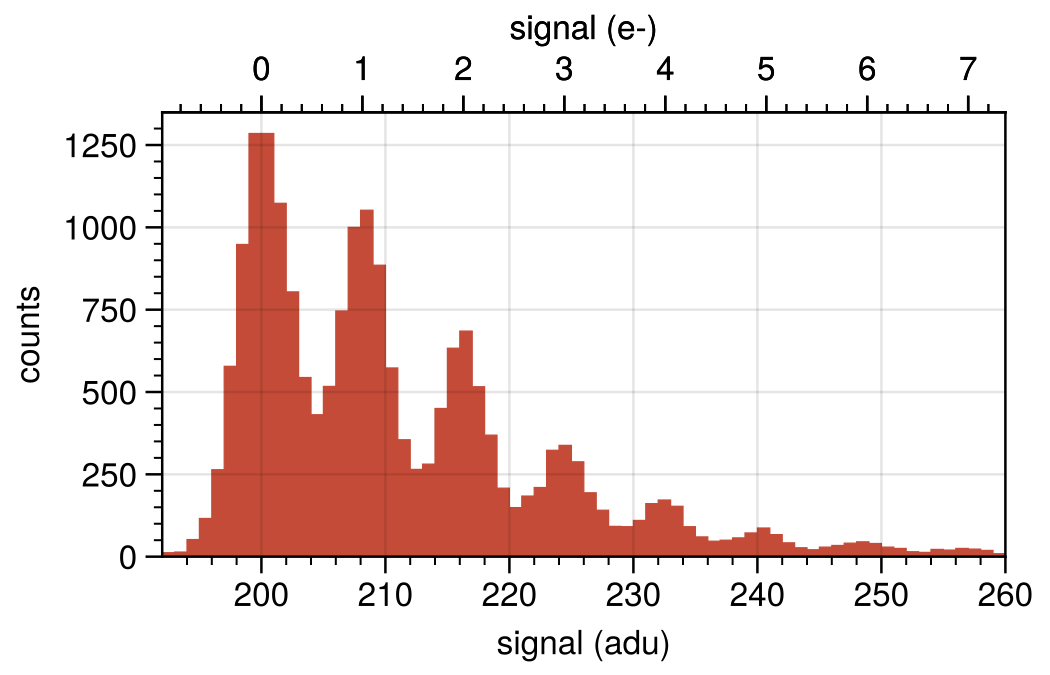
Photon counting histogram fit to an 800x256 subwindow of low-signal data.
VAMPIRES Filters
| VAMPIRES Standard Filters | ||||||
|---|---|---|---|---|---|---|
| Filter name | Central wavelength (nm) | Effective width (nm) | Cut-on/off wavelengths* (nm) | Zero point** | Notes | |
| e-/s | mag | |||||
| 625-50 | 625 | 48 | 599 - 652 | 4.56e9 | 24.1 | Poor calibration source throughput |
| 675-50 | 675 | 48 | 649 - 702 | 6.47e9 | 24.5 | |
| 725-50 | 725 | 48 | 699 - 751 | 7.11e9 | 24.6 | Optimal polarimetric efficiency. |
| 750-50 | 748 | 48 | 722 - 774 | 5.96e9 | 24.4 | |
| 775-50 | 763 | 26 | 748 - 778 | 1.91e9 | 23.2 | Overlaps with PyWFS dichroic |
| Open | 678 | 192 | 566 - 778 | 2.27e10 | 25.9 | Constrained by AO188 dichroic and PyWFS dichroic. |
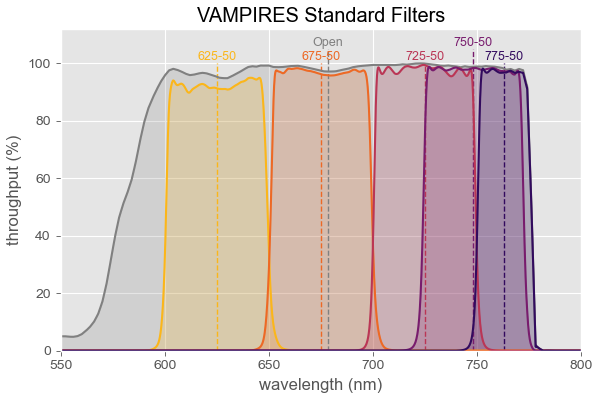
Throughput curves for the 5 bandpass filters in VAMPIRES. Link to raw data.
Multi-band Imaging (MBI)
In S23B we deployed a new multi-band imaging (MBI) mode which uses a stack of dichroics at slightly offset angles of incidence to form multiple images across the detectors. A schematic of the principle is shown below. This mode is compatible with all observing modes except the narrowband spectral differential mode.
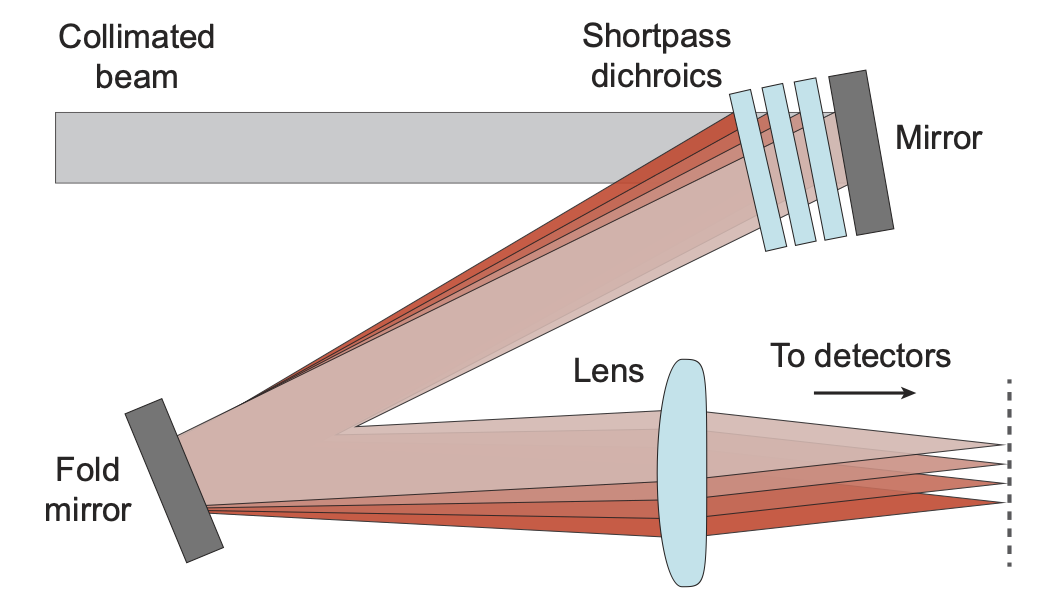
Schematic of the MBI mode.

High-strehl observations of a 75 mas separation binary with multiband imaging.
MBI Filter information
| VAMPIRES MBI Filters | ||||||
|---|---|---|---|---|---|---|
| Filter name | Central wavelength (nm) | Effective width (nm) | Cut-on/off wavelengths* (nm) | Zero point** | Notes | |
| e-/s | mag | |||||
| F610 | 612 | 60 | 569 - 646 | 3.73e9 | 23.9 | Overlaps with AO188 dichroic; poor calibration source throughput |
| F670 | 670 | 43 | 644 - 695 | 4.85e9 | 24.2 | |
| F720 | 719 | 46 | 693 - 744 | 6.54e9 | 24.5 | |
| F760 | 760 | 32 | 742 - 778 | 2.95e9 | 23.7 | Overlaps with PyWFS dichroic |
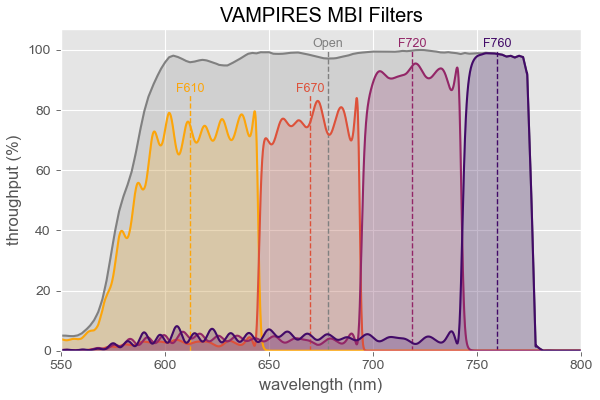
Throughput curves for the bandpasses in the MBI mode. Link to raw data.
Polarimetry
VAMPIRES has two different polarimetry modes: "slow" mode, which uses an upstream half-wave plate (HWP) to slowly modulate the polarization state and "fast" mode, which includes a fast achromatic liquid crystal (AFLC) to quickly modulate the signal. For both modes the light is split by a polarizing beamsplitter cube to simultaneously measure orthogonal polarization states on each camera. Note: the HWP is upstream from AO188, which requires synchronization if you want to operate in PDI mode simultaneously with other SCExAO instruments. Currently the HWP can be synced across VAMPIRES, FastPDI, and CHARIS.
| VAMPIRES Polarimetry | |||
|---|---|---|---|
| Slow | HWP | HWP: 10 s - 60 s | Uses double-difference method. |
| Fast | HWP + AFLC | HWP: 10 s - 60 s AFLC: every frame |
AFLC requires exposure times <1s. Uses triple-difference method. |
Data-processing and calibration
VAMPIRES uses double-difference for slow polarimetry mode and triple-difference for the fast mode. The instrumental polarization is calibrated using an empirical Mueller matrix model fit to polarized flat fields. We recommend observing a polarized and unpolarized standard star during your observations if polarimetric accuracy is paramount.
Coronagraphy
VAMPIRES is equipped with a classic Lyot coronagraph with the combination of a focal-plane mask and a pupil stop. The coronagraph can be used with any full-pupil observing mode (i.e., cannot be used with the sparse aperture masks). For moderately faint targets (9 < I < 11 mag) the coronagraph can be deployed without the Lyot stop to maximize the signal-to-noise ratio at the cost of diffraction control (e.g., protoplanetary disk imaging).
| VAMPIRES Coronagraphy | ||
|---|---|---|
| IWA | 37, 59, 105, and 150 mas | Focal plane mask inner working angles. Roughly 2, 3, 5, and 7 λ/D at 750 nm. |
| Lyot throughput | 62.8% | Geometric pupil throughput compared to SCExAO pupil |
| Raw contrast ratio | 1e-4 at 0.1" 1e-6 at >0.6" |
Contrast measured without PSF subtraction which is limited by residual wavefront errors. Read noise limited beyond 0.2". |
| Setup time | 5 minutes | This includes fine adjustments to the focus and alignment of the focal plane and pupil masks. |
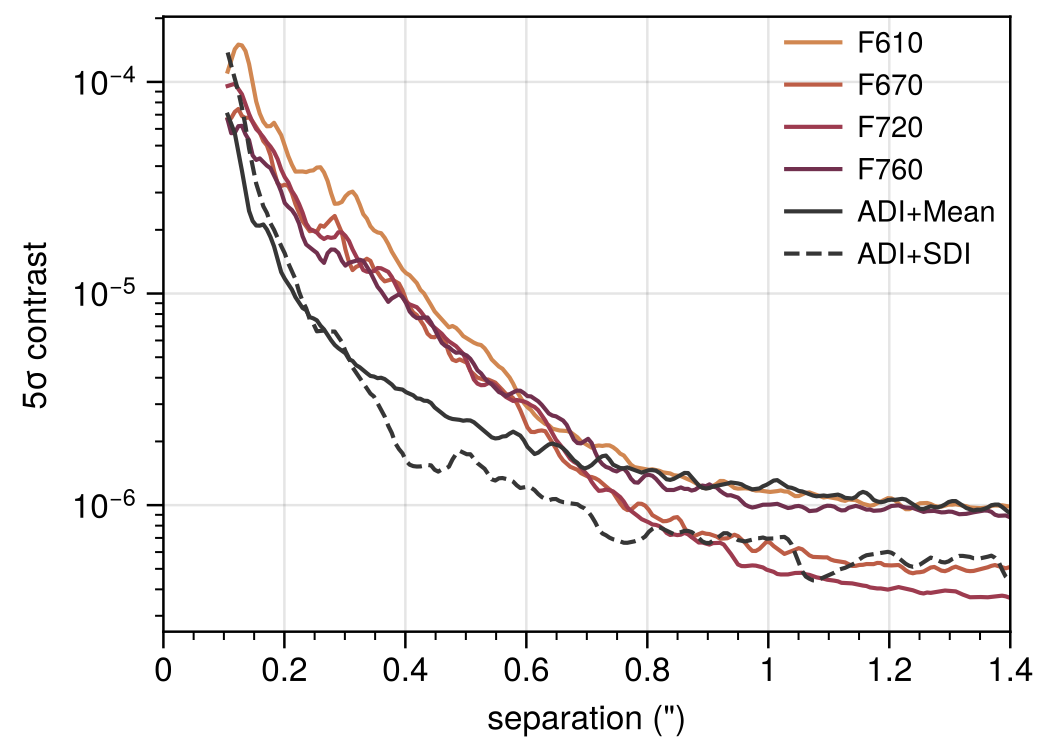
Throughput-corrected 5sigma contrast curves in multiband imaging mode with the CLC-5 coronagraph. SDI processing improves contrast in the control region, reaching 10e-6 at 0.6"
Calibration
Calibration is performed via artifical speckles generated by the deformable mirror which have a known angular offset and differential photometry compared to the star. This allows astrometric and photometric calibration of the star behind the focal plane mask.
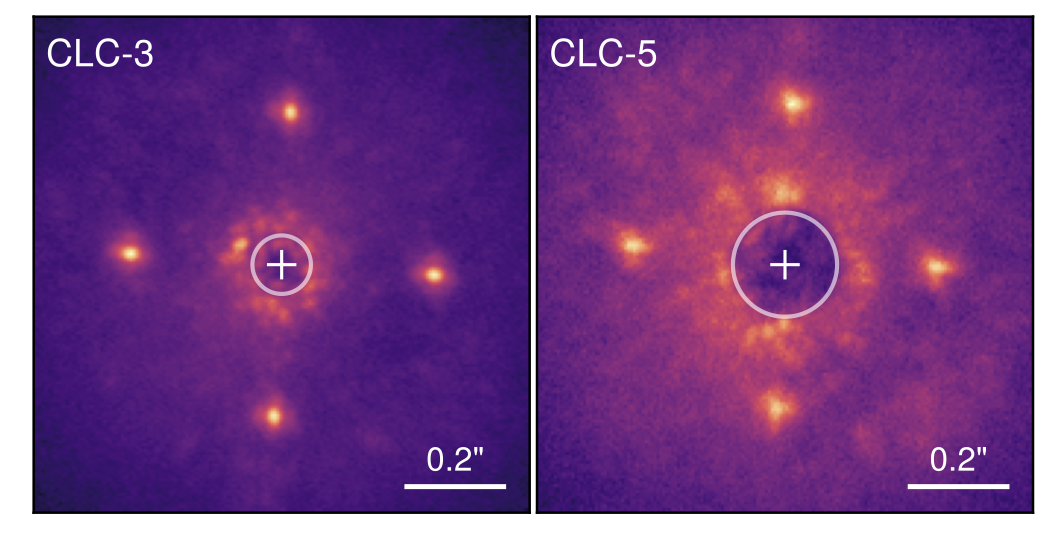
On-sky coronagraphic images with astrogrid calibration speckles
Focal plane masks
| VAMPIRES Focal Plane Masks | |||
|---|---|---|---|
| Name | Mask radius (μm) | IWA* (mas) | Notes |
| CLC-2 | 46 | 37 | Lots of leakage |
| CLC-3 | 69 | 59 | Typical mask for polarimetric observations or good wavefront correction |
| CLC-5 | 116 | 104 | Typical mask for mediocre wavefront correction |
| CLC-7 | 148 | 150 | Not super well-matched to Lyot stop |
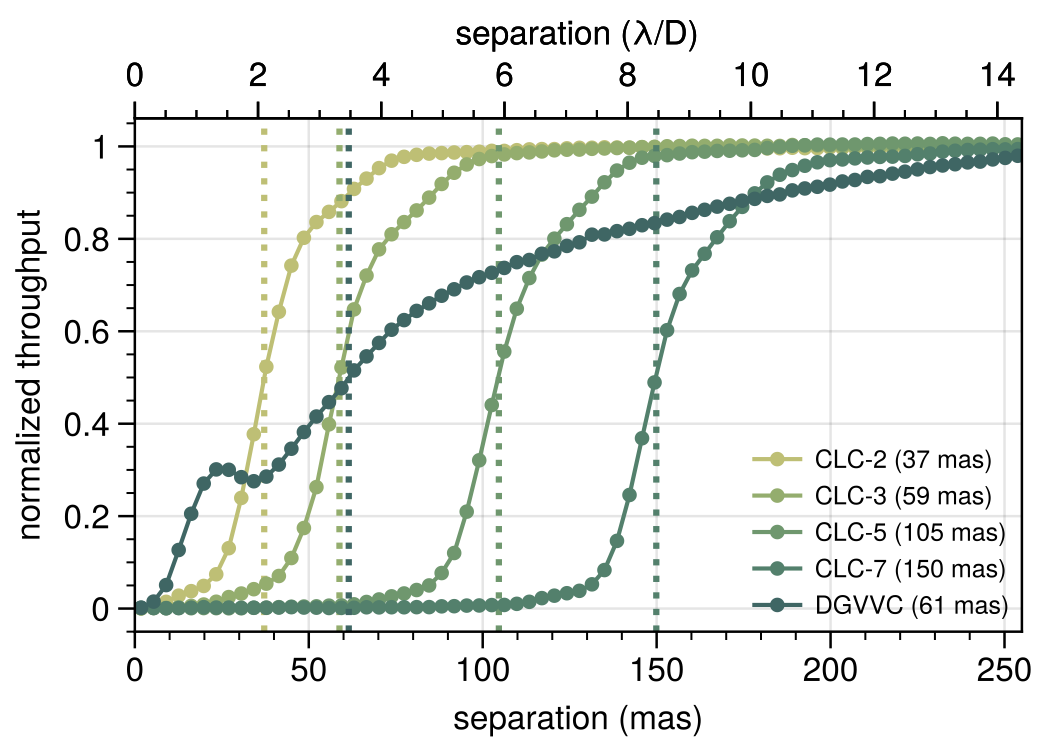
Normalized throughput curves using the internal calibration source. 50% throughput is marked with black horizontal line and the mask IWAs are marked with vertical dashed lines.
Sparse Aperture Masking
Sparse aperture masking (SAM) allows the full diffraction limit of the telescope to be recovered by using selected sub-pupils of the telescope pupil as interferometer baselines. See, for example, Tuthill, et al. (2000), PASP, 112, 555; Huelamo, et al., (2011), A&A, 528, L7; Kraus & Ireland, (2012), ApJ, 745, 5.
| Sparse Aperture Masking | ||
|---|---|---|
| Sub pupil configurations | 7 hole, 9 hole, 18 hole and annulus masks | Masks are selectable depending on brightness of target. See figure below for mask options. |
| Limiting magnitudes | 18 hole (I ~2-3 mags) | A function of the size and number of holes in the mask (i.e. Fourier coverage). However ongoing upgrades are pushing the detection limit fainter. |
| 7 hole (I ~ 7) | ||
Calibration
Calibration is performed via the observation of a PSF calibrator star, as per the conventional sparse aperture-masking methodology. This mode is ideal for the detection of faint companions and unpolarized circumstellar structure at very close separations (10s of mas).
Narrowband / Spectral Differential Imaging
Simultaneous spectral differential imaging (SDI) using either H-alpha or SII lines can be performed. Imaging is performed simultaneously on two cameras via a non-polarizing beamsplitter, with an H-alpha (or SII) filter before one camera and an adjacent continuum filter before the other. Filters can be rapidly swapped between cameras to help calibrate non common path errors. This mode may be used with both aperture-masking and full-pupil imaging and is compatible with polarimetry.
Current contrast limits are 1e-3 at 50 mas and 1e-4 at >350 mas (Feb. 2019). Note this mode is in continuous development and contrast limits are expected to further improve.
| VAMPIRES Narrowband Filters | |||||
|---|---|---|---|---|---|
| Filter name | Central wavelength (nm) | Effective width (nm) | Cut-on/off wavelengths* (nm) | Zero point** | |
| e-/s | mag | ||||
| Ha | 656.3 | 1 | 655.7 - 656.9 | 6.45e7 | 19.5 |
| Ha-Cont | 647.7 | 2 | 646.4 - 649.1 | 2.09e8 | 20.8 |
| SII | 672.7 | 3 | 670.7 - 674.5 | 4.31e8 | 21.6 |
| SII-Cont | 681.5 | 3 | 679.6 - 683.4 | 4.07e8 | 21.5 |
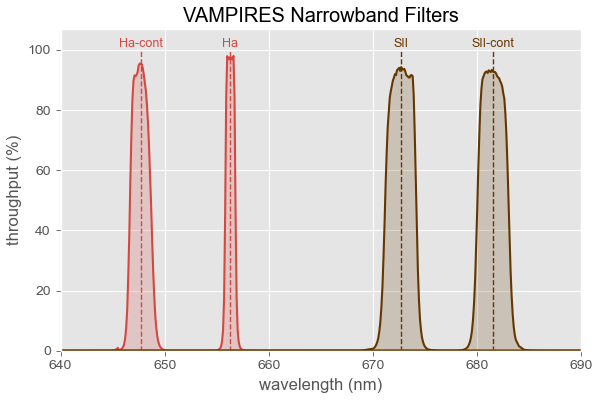
Throughput curves for the narrowband filters in the differential filter wheel. Link to raw data.
VAMPIRES Instrument Diagram
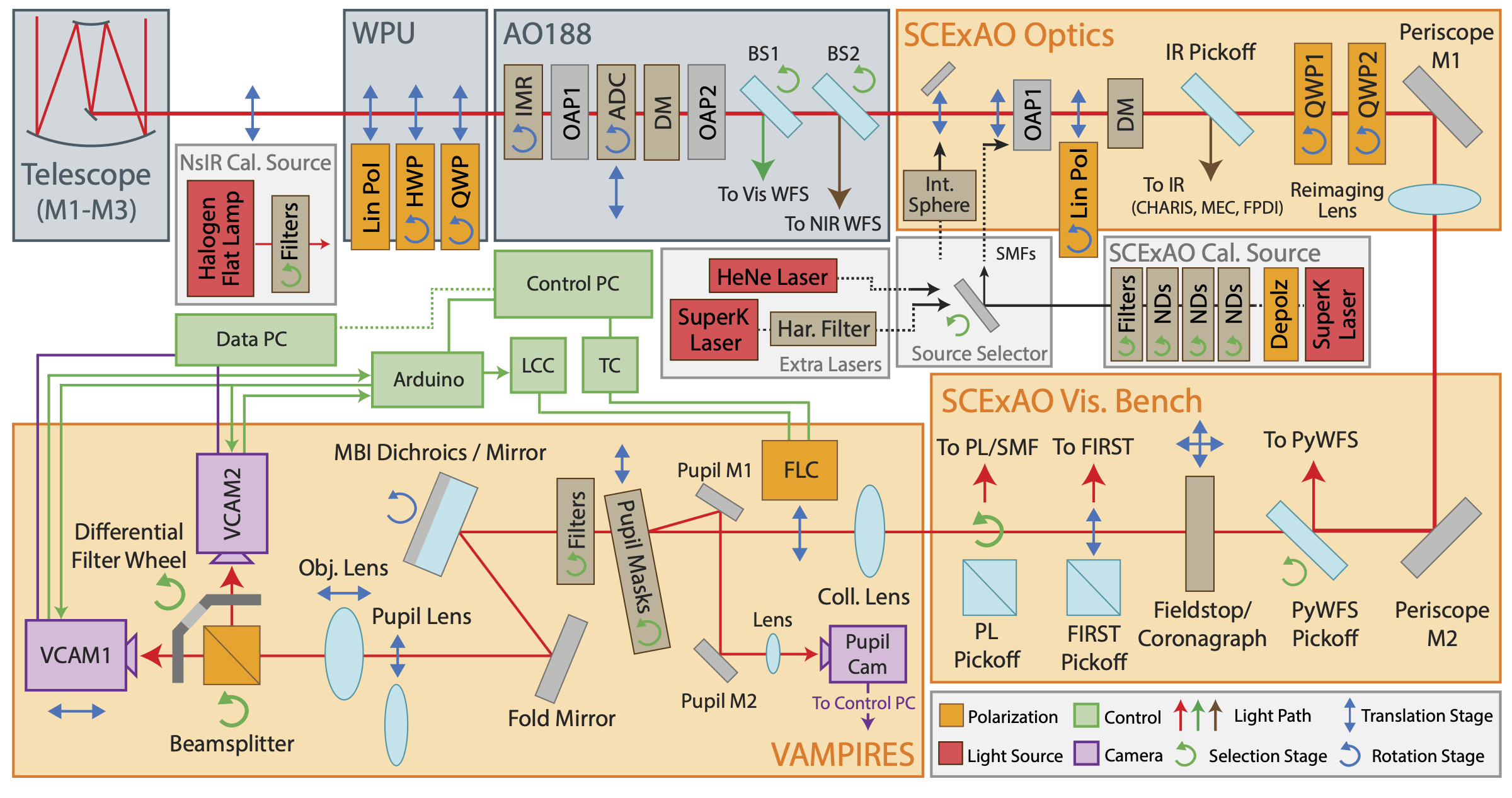
Diagram of the VAMPIRES light path.
Old Information
The Visible Aperture Masking Polarimetric Interferometer for Resolving Exoplanetary Signatures (VAMPIRES) instrument draws on the established success of sparse aperture masking interferometry (also known as non-redundant masking) and combines it with differential polarimetry, to provide diffraction limited scattered-light imaging of circumstellar environments. Primary science targets include protoplanetary disks as well as the mass-loss shells of evolved stars. It is being developed in collaboration with a team from the University of Sydney, Australia, consisting of Peter Tuthill, Barnaby Norris, Guillaume Schworer and Paul Stewart.
Sparse aperture masking (SAM) allows the full diffraction limit of the telescope to be recovered by using selected sub-pupils of the telescope pupil as interferometer baselines. See, for example, Tuthill, et al. (2000), PASP, 112, 555; Huelamo, et al., (2011), A&A, 528, L7; Kraus & Ireland, (2012), ApJ, 745, 5. The addition of differential polarimetry allows SAM’s differential observables to be far more precisely calibrated, while providing polarization information of the target.
In a technique complementary to infrared coronagraphy, VAMPIRES provides an effective inner-working-angle at 600 to 800 nm of ~10 mas, depending on the contrast ratio. A comprehensive description of the instrument is given in Norris, et al. (2015), MNRAS, 447, 3. The science potential of VAMPIRES’ core technique - differential polarimetric spare aperture masking - is demonstrated in Norris, et al., (2012), Nature, 484, 220.
An instrument schematic is given below. Three tiers of differential calibration allow interferometric visibilities to be calibrated to 0.1%, and closure phases to better than a degree. In its primary mode (with masks and the polarimeter), VAMPIRES offers spatial resolution at the diffraction limit (<10 mas), while having a relatively small field-of-view — around ~500 mas — as defined by the shortest baseline. The sensitivity of VAMPIRES observations in the primary mode is determined by the contrast ratio between the unresolved stellar flux and the overall scattered-light flux from the circumstellar dust. As a guide, a star:disk contrast ratio of 1000:1 provides a 1 sigma detection on a single baseline. Depending on the aperture mask employed, typically hundreds or even thousands of baselines (in the case of the annular mask) are measured.
In addition to the primary differential-polarized SAM mode, VAMPIRES also offers several additional modes: conventional masking mode (non-polarized) and a polarized imaging mode (full pupil, no masks).
VAMPIRES can operate simultaneously with SCExAO/HiCIAO NIR observations. While wavelengths > 1μm are sent to SCExAO’s IR channel and HiCIAO, shorter wavelengths are sent to the SCExAO visible channel (including the pyramid WFS) and VAMPIRES.
The data product produced by VAMPIRES is a set of differential interferometric Visibilities and Closure Phases. The team at the University of Sydney provide expertise in interpretation of these data, including model-fitting. An example data set is shown in the figure below.

(Top left) Schematic diagram of the VAMPIRES instrument. (Bottom left) Aperture mask choices in VAMPIRES, with corresponding Fourier coverage. (Right) Example data set. Results from mu Cep taken in September 2014 which provided precise measurements of a circumstellar dust shell (radius 18 mas). Full analysis of this data is currently underway.
File ./030openuse.web/040vampires.web/content.html last modified 04/08/2025 09:19:08 HST
